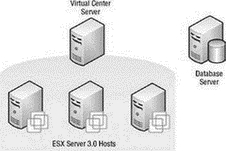Книга: Mastering VMware® Infrastructure3
Installing the VirtualCenter Back-end Database
Разделы на этой странице:
By now, you have a good understanding of the importance of VirtualCenter in a large enterprise environment. As noted in the introduction to this chapter, all things VirtualCenter are stored in a back-end database. So the truth is that the back-end database, not so much the front-end VirtualCenter, is the key component. Without the back-end database, you will find yourself rebuilding an entire infrastructure. Figure 5.4 illustrates the components of a typical Virtual Server infrastructure.

Figure 5.4 VirtualCenter acts as a proxy for managing ESX Server 3.0 hosts. All of the data for Virtual-Center is stored in an external database.
VirtualCenter Business Continuity
Losing the server that runs VirtualCenter might result in a small period of downtime; however, losing the back-end database to VirtualCenter could result in days of downtime and extended periods of rebuilding.
As with most enterprise-level databases that store critical company data, you will want to take especially good care of and take precautions with the VirtualCenter database. Whether this means building the database on a server cluster that provides high availability, or developing a rock-solid backup strategy to ensure smooth and timely restore in the event of loss, measures must be taken to guarantee access and availability of VirtualCenter data.
In light of the sensitive and critical nature of the data in the VirtualCenter database, VMware will only support VirtualCenter issues with back-end databases on enterprise-level database applications. VirtualCenter 2.0.1 supports the following database applications:
? Oracle 9i
? Oracle 10g
? Microsoft SQL Server 2000 with Service Pack 4
? Microsoft SQL Server 2005 with Service Pack 1
? Microsoft SQL Server Desktop Engine (MSDE)
VirtualCenter Database Support
SQL Server 2005 Service Pack 1 is not supported on VirtualCenter 2.0.0. To use SQL Server 2005 Service Pack 1 as the back-end database for VirtualCenter, you must be running VirtualCenter 2.0.1 or higher.
For administrative purposes, you might find it easy to install the database application and the VirtualCenter application on the same computer. This configuration, however, is not considered best practice as you would then have a single point of failure for two core components of the virtual infrastructure. The more common, and recommended, infrastructure design includes deploying VirtualCenter and its back-end database on two different computers. Later in this chapter we will explore some options for building a highly available VirtualCenter installation.
Connecting VirtualCenter to its back-end database requires that an Open Database Connectivity (ODBC) connection be created on VirtualCenter. The ODBC connection should be created under the context of a database user who has full rights and permissions to a database that has been created specifically for storing VirtualCenter data.
- Introducing VirtualCenter 2.5
- The Bottom Line
- Информация заголовочной страницы (Database header)
- Database dialect
- 4.4.4 The Dispatcher
- DATABASE CACHE SIZE
- About the author
- Chapter 7. The state machine
- Chapter 5 Installing and Configuring VirtualCenter 2.0
- Appendix A. Detailed explanations of special commands
- Appendix B. Common problems and questions
- Appendix C. ICMP types




